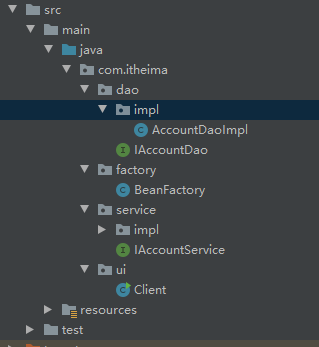//properties accountService=com.itheima.service.impl.AccountServiceImpl accountDao=com.itheima.dao.impl.AccountDaoImpl
1.ioc的缘由
为什么要工厂?
因为为了减少依赖,依赖包括编译器的依赖和实体类之间的依赖,简单来说,就是你A类中需要你写的B类,使用new的方法就会造成他们之间的依赖
而使用工厂,就是在他们之间加了一层
为什么要加一层?
因为类与类之间的依赖是非常麻烦的,尤其是项目复杂以后。所以我们使用工厂,有工厂替我们管理,所以专业名词出来了--控制反转,因为dao类把创建
的权利放弃了,交给了工厂,因此叫控制反转而不是减少依赖
自定义工厂实例
项目图

package com.itheima.ui; import com.itheima.factory.BeanFactory; import com.itheima.service.IAccountService; /** * 模拟一个表现层,用于调用业务层 */ public class Client { public static void main(String[] args) { //IAccountService as = new AccountServiceImpl(); for(int i=0;i<5;i++) { IAccountService as = (IAccountService) BeanFactory.getBean("accountService"); System.out.println(as); as.saveAccount(); } } }
package com.itheima.service; /** * 账户业务层的接口 */ public interface IAccountService { /** * 模拟保存账户 */ void saveAccount(); }
/** * 账户的业务层实现类 */ public class AccountServiceImpl implements IAccountService { // private IAccountDao accountDao = new AccountDaoImpl(); private IAccountDao accountDao = (IAccountDao)BeanFactory.getBean("accountDao"); // private int i = 1; public void saveAccount(){ int i = 1; accountDao.saveAccount(); System.out.println(i); i++; } }
package com.itheima.factory; import java.io.InputStream; import java.util.Enumeration; import java.util.HashMap; import java.util.Map; import java.util.Properties; /** * 一个创建Bean对象的工厂 * * Bean:在计算机英语中,有可重用组件的含义。 * JavaBean:用java语言编写的可重用组件。 * javabean > 实体类 * * 它就是创建我们的service和dao对象的。 * * 第一个:需要一个配置文件来配置我们的service和dao * 配置的内容:唯一标识=全限定类名(key=value) * 第二个:通过读取配置文件中配置的内容,反射创建对象 * * 我的配置文件可以是xml也可以是properties */ public class BeanFactory { //定义一个Properties对象 private static Properties props; //定义一个Map,用于存放我们要创建的对象。我们把它称之为容器 private static Map<String,Object> beans; //使用静态代码块为Properties对象赋值 static { try { //实例化对象 props = new Properties(); //获取properties文件的流对象 InputStream in = BeanFactory.class.getClassLoader().getResourceAsStream("bean.properties"); props.load(in); //实例化容器,我简单的认为,容器就是保存你所要的类的配置 beans = new HashMap<String,Object>(); //取出配置文件中所有的Key Enumeration keys = props.keys(); //遍历枚举 while (keys.hasMoreElements()){ //取出每个Key String key = keys.nextElement().toString(); //根据key获取value String beanPath = props.getProperty(key); //反射创建对象,我自己认为就是通过class.forName可以创建一个object对象,把创建的对象存入beans对象 Object value = Class.forName(beanPath).newInstance(); //把key和value存入容器中 beans.put(key,value); } }catch(Exception e){ throw new ExceptionInInitializerError("初始化properties失败!"); } } /** * 根据bean的名称获取对象 * @param beanName * @return */ public static Object getBean(String beanName){ return beans.get(beanName); } /** * 根据Bean的名称获取bean对象 * @param beanName * @return public static Object getBean(String beanName){ Object bean = null; try { String beanPath = props.getProperty(beanName); // System.out.println(beanPath); bean = Class.forName(beanPath).newInstance();//每次都会调用默认构造函数创建对象 }catch (Exception e){ e.printStackTrace(); } return bean; }*/ }
package com.itheima.dao; /** * 账户的持久层接口 */ public interface IAccountDao { /** * 模拟保存账户 */ void saveAccount(); }
package com.itheima.dao.impl; import com.itheima.dao.IAccountDao; /** * 账户的持久层实现类 */ public class AccountDaoImpl implements IAccountDao { public void saveAccount(){ System.out.println("保存了账户"); } }



